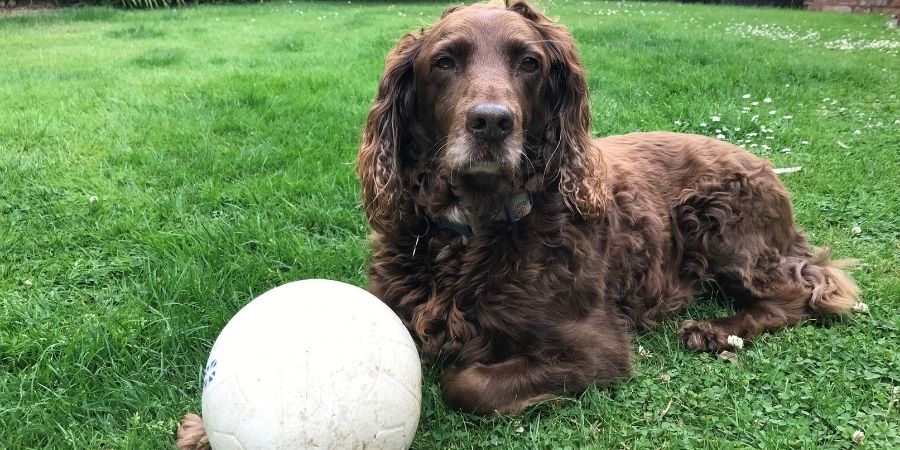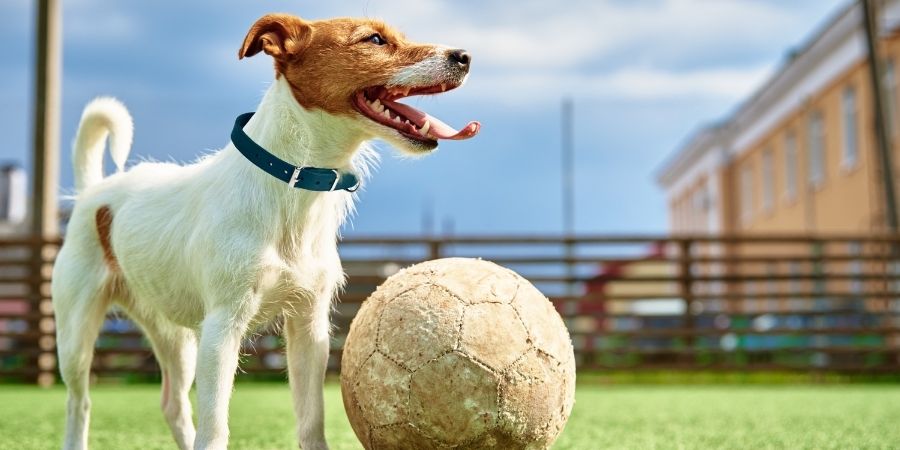Use a puzzle ball
Puzzle balls are a great way to keep your pets entertained and focused. Filled with their favourite treat or food, they provide mental stimulation for your four-legged friend, which can be more tiring than a regular walk - which might give you just enough time to watch the football without distraction. Pets can use their nose and feet to wobble and move the ball- so you might find your pet ‘dribbling’ their puzzle ball like a pro.
Try out different shapes balls
Football-size balls are often safer for dogs to play with, but dogs can struggle to pick up large spherical shape balls in their mouths! So it’s worth investing in some different shapes that they can grab onto properly. Rugby-type, grid or textured balls are all easier for pets to hold in their mouths- or if you want to stick with a more classic football try softer balls or partially deflated ones which your dog might find easier to carry.

It’s very important to ensure you’re selecting suitable size toys for your pet. Mini footballs, golf or tennis balls can all pose a choking risk to dogs (especially larger breeds who could easily swallow them).
Be cautious of the weather
Avoid outdoor activity on hot or humid days. Ball obsessions can mean that dogs don’t stop when they should causing them to overheat, even if the weather doesn’t seem to warm to. Almost 3 out of every 4 heatstroke cases are caused by exercising in hot weather so always think about the temperature before starting a game, especially in the middle of the day.
Dogs needs to warm up too
Like football players, dogs can also find themselves with strains and sprains (or even more serious injuries) during strenuous games. A warm-up and cool-down should be part of the activity; this can be in the form of a gentle walk before play time starts.

Make sure your dog is playing by the rules
If you want to play a ball game with your dog, instead of including them in your footie practice it’s best to set up their own version to keep them safe. The force of a kicked football can bruise your dog and jumping, chasing or fast turns during the game can lead to injuries. Here are a few guidelines for doggie football:
- Teach them the rules of play. There are lots of different football themed games you can play with your dog. As a couple of ideas, you could play ‘football fetch’ by rolling the ball for them to bring back or teach your dog to ‘score’ by carrying their ball through some goal posts. Whatever you choose, it’s important your dog knows what they’re meant to do and how to be safely involved- they’ll enjoy the game much more if they understand the rules.
- Avoid injuries. Keep balls low to the ground to avoid jumping, allow your dog to catch the ball during the game and give them regular breaks. This will avoid frustration for your dog and reduce the risk of accidents.
- Make sure they know when to stop. Teaching your dog to ‘stop’ and ‘leave’/’drop’ are essential before you start the game so you can keep things under control, especially if your dog gets very excited while playing.
- Give your dog their own ball. Injuries can occur if your dogs (or other family members) are tackling each other for the ball. It can also be very stressful for your dog to share if their ball is their favourite toy, so make sure there are plenty of options for everyone to have a good time.
- Supervise any games. This is especially important if there are kids nearby. An overexcited dog could accidentally ‘tackle’ or hurt a child if they’re trying to get the ball. We’d recommend having a separate game for kids and dogs to make sure everyone is safe.
Keep your distance if your dog is ‘on the bench’
Dogs who have a high prey drive or who love to play fetch may instinctively chase other people’s footballs, for dog owners this can be a highly frustrating and stressful situation.
It’s always important to keep your dog under control when out in public, but this is even more important if they might become overexcited and destroy a football or injure someone when they try to play.
Keep your dog on a lead if there are ball games nearby and reward your dog for focusing on you, not the football. You can always play your own game with them once you get back home!
Know when to stop
There are always risks in over-exercising your dog, so it’s essential to supervise closely to avoid accidents. Build up any exercise slowly, keeping sessions short at the start, so your dog can build up their muscles and stamina.
Some ball obsessed dogs may become over excited and not realise it’s time to stop, in extreme cases this can lead to sprains, injuries or heatstroke. Make sure your dog has a clear command so they know the game is over when it’s time to calm down.
It’s also important to check your dog’s ball regularly during and after the game. Choking or gut obstruction is also a potential hazard as broken pieces of the ball could be swallowed amongst the excitement, so check toys regularly for signs of damage.
